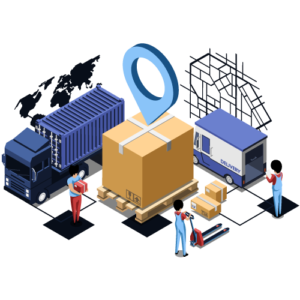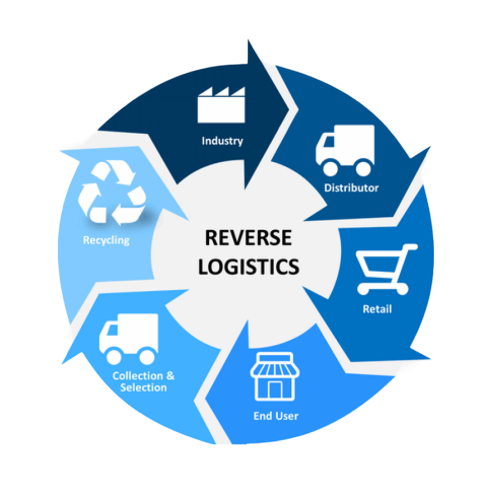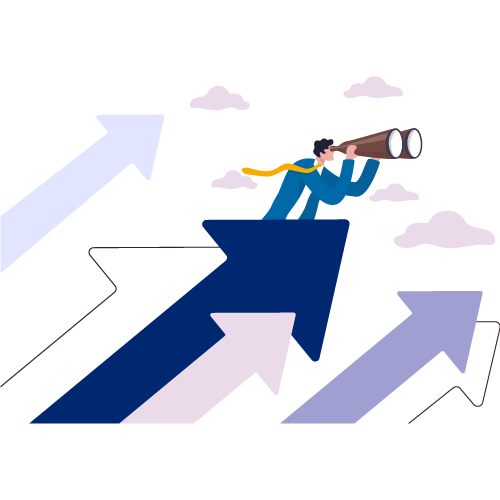
Reverse logistics-USA
Build Agile and Simplified Reverse Logistics Process:
Get our customized reverse logistics services tuned to meet the requirements of your supply chain. Execute reverse logistics with seamless ease to match your business and customer needs.
Request a Pickup
What is Reverse logistics? Why it is Important?
In the supply chain, the upstream movement of products from customers back to sellers/manufacturers is called reverse logistics. Thus, the supply chain travels backward. Reverse logistics is concerned with product return, maintenance, and repair. It ensures the completion of the product lifecycle, minimizes costs, helps capture the maximum value of products, and eliminates risks. Overall, it ensures minimal waste production.

Types of Reverse logistics
Returns management
It includes proactive management of returned goods so that it reaches back to the right entity. A well-established return pipeline and policies help ensure customer satisfaction.
Remanufacture or Refurbishment
It is concerned with repairing/reworking the goods to increase their shelf life. The goods’ condition is evaluated to determine if it is suitable for remanufacturing.
Repair and maintenance
Customers can avail of suitable repair or maintenance services to restore the product’s condition. Via reverse logistics, the goods travel to the manufacturer for repair/maintenance.
When does reverse logistics become necessary?
The reverse logistics process is integral in the supply chain to ensure that the product is available for reuse or remanufacture, or to recoup value. It is necessary to ensure an efficient and effective flow of goods. The goal is to recover value or ensure that is properly disposed of.


What are the advantages of efficient reverse logistics?
The importance of reverse logistics has been widely acknowledged in recent times. It is centered around the 5 R’s, i.e., resell, repair, return, recycle, and repackage. Thus, the stakeholders can implement it to complete the product lifecycle. Efficient reverse logistics offers opportunities to extract optimal value from obsolete products. It also helps to protect the environment through the safe disposal of products.
Five stages of reverse logistics
The reverse logistics process undergoes the following stages in the supply chain.
Return processing
Primarily, the organization must align the return pipeline that will put the return process in motion. Hence, when the customer initiates the return, it will enable smooth, hassle-free movement.
Select the appropriate return category
Once the product is returned, the apt return category must be determined. The stakeholder must decide whether it should be refurbished, recycled, or forwarded for resale.
Move Products to Reduce Waste
The returned items must stay in motion to minimize waste. They should not sit in a particular location which may create a blockage. Based on the category, they must continue their journey in the supply chain and enter the right stream.
Execute the Repair Process
Items that can be repaired should immediately undergo the rework/repair process. They can then enter the organization’s inventory if they can still offer value to the market.
Recycle items that cannot be resold or Repaired
Those items that cannot be repaired and are not suitable for reselling must enter the recycling stream. It is an eco-friendly process that reduces pressure on the environment to generate raw materials.
Message us! Know how it works.
Give us a try. Discover More!
We are always ready to help our customers with the best advice and assistance.
Reverse logistics is concerned with activities such as returns, repairs, recalls, recycling, and repackaging. It is typically useful for recovering value or ensuring proper disposal.
Forward logistics refers to the management of a product’s forward movement from raw materials to end consumers. In contrast, reverse logistics is the backward travel of goods from the final destination to manufacturers/suppliers.
Our efficient reverse logistics strategy allows us to quickly place the item to be returned on the supply chain, ensure smooth movement, and quickly return it to the manufacturer.
The cost of reverse logistics service depends on the combination of solutions you require, labor and efforts involved, and estimated time. We provide you with the best, cost-effective reverse logistics services.
Talk to our Service Experts.
Our experts with exceptional knowledge and experience in the field ensure you get top-quality ITAD services.
 USA
USA UK
UK UAE
UAE India
India